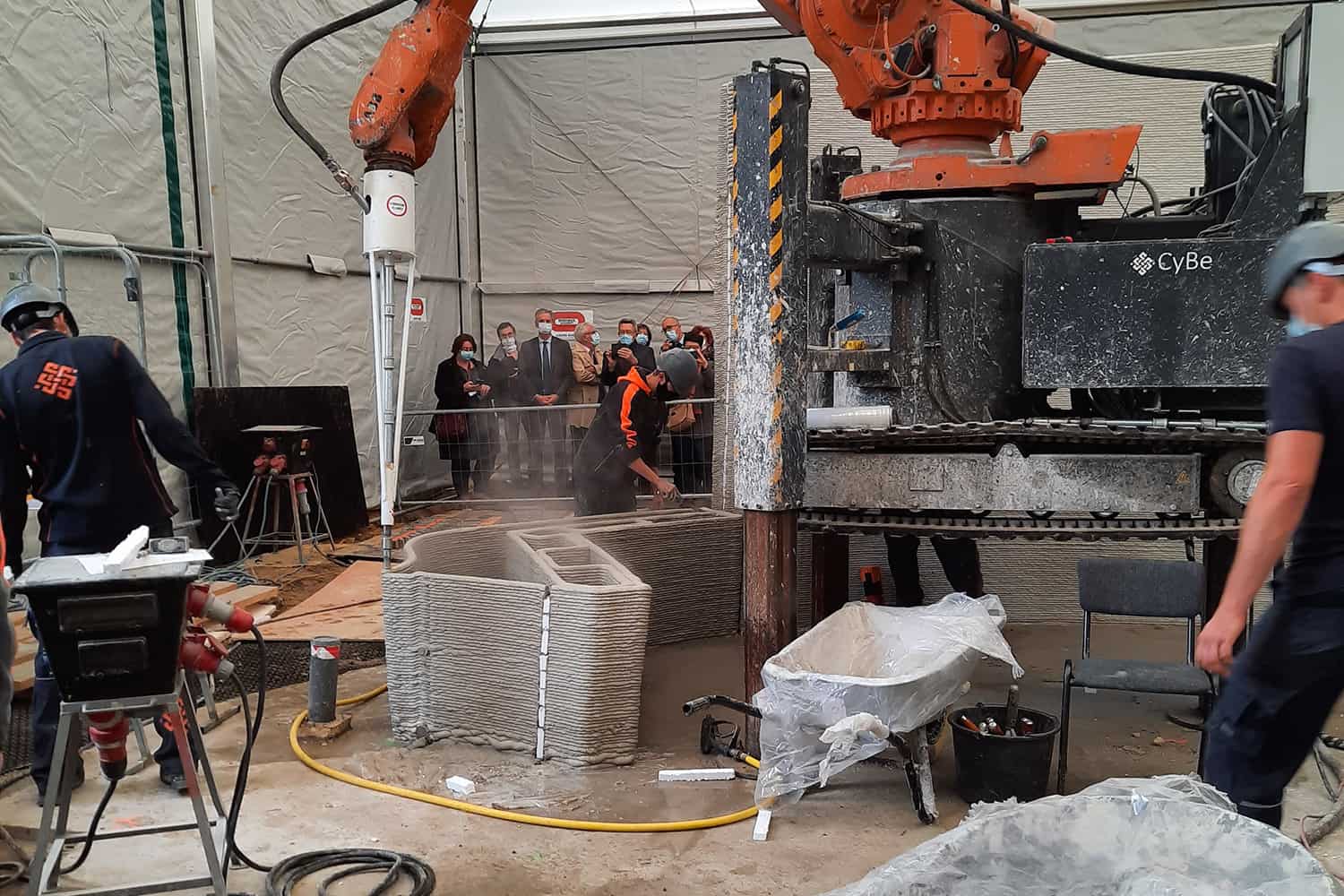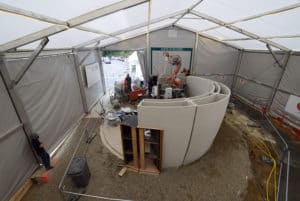
The future of 3D printing in construction – interview with Bruno Linéatte, Director of R&D for Building Construction Methods at Bouygues Construction
4 minutes of reading
Bouygues Immobilier Grand Ouest gained prominence recently for using 3D printing to build “La Sphère”, a reception building for a public housing project in Harfleur on behalf of Immobilière Basse Seine – 3F Group. What challenges await this innovative mode of construction?
Read on for answers from Bruno Linéatte, Director of R&D for Building Construction Methods at Bouygues Construction.

What possibilities does 3D printing currently offer the construction sector?
BL: 3D printing makes it possible to custom-build complex, architecturally spectacular structures that are still competitive. So 3D printing is not a replacement for traditional construction: in my view, it is not suitable for creating simple, inexpensive things, which other forms of industrialisation are better abl e to produce. Consider the aeronautics and automotive industries, which have a 10- or 15-year head start on construction in terms of 3D printing. The technology is only used in production to make parts which are usually extremely complex or very light, making it less costly than other manufacturing methods. The same principle applies to construction. To build using 3D printing, the techniques available consist primarily in additions from material deposits. A robotic arm or a matrix printer operating a Cartesian gantry deposits layer upon later of matter. In most cases, the material is concrete or a special mortar. Other actors, such as the Université de Nantes or M.I.T. base their technology on polyurethane, which is deposited as formwork to pour concrete; it is then left in place, integrated into the building to improve insulation. There are other techniques, including injecting a binder into powder, which have not yet yielded the results desired.
To build using 3D printing, the techniques available consist primarily in additions from material deposits. A robotic arm or a matrix printer operating a Cartesian gantry deposits layer upon later of matter. In most cases, the material is concrete or a special mortar. Other actors, such as the Université de Nantes or M.I.T. base their technology on polyurethane, which is deposited as formwork to pour concrete; it is then left in place, integrated into the building to improve insulation. There are other techniques, including injecting a binder into powder, which have not yet yielded the results desired.

What examples are there to illustrate this new mode of constructive?
BL: There are many experimental examples and demonstration structures around the world: some are developed at universities, while others are backed by construction companies There are not so many commercially viable examples. The version that is most widely covered in the media is on-site 3D printing, but the more efficient approach seems to be off-site printing, in a plant. In sheer numbers, that method is slightly more common than printing at the construction site. The first major demonstration for the media took place in China in 2014 when Winsun built a series of 3D-printed housing cubes at its plant. Closer to home, France has also been in on the action: for example, Université de Nantes and Bouygues Immobilier Grand Ouest teamed up to produce “Yhnova”, which was printed in polyurethane by a 7-axis robot, for Nantes Métropole Habitat in 2017. That was the first printed house in the world to actually be occupied. Last month in Harfleur, we built “La Sphère” with the Dutch start-up CyBe and their 7-axis robot. It is a caretaker’s home on the site of a residential complex, whose walls were printed on site in concrete. That project gives a glimpse of how 3D printing could lead to material savings in response to environmental challenges: the structure used about 30% less concrete than a traditional construction of the same shape by printing very thin surfaces. Other stakeholders are also working on this subject: with the “Villaprint” project for Plurial Novilia, Xtreee’s factory is about to print concrete wall components for use in five single-family townhomes. These three examples are the only buildings in France that are built mostly with 3D printing and funded by a non-builder client. Those clients sought to invest in making construction history and wanted to drive technical progress, by taking on some of the construction cost, which could be reduced in the future. The structures for which 3D printing could be profitable in the short term are complex buildings, for which traditional construction would require pricey formwork.What might be the future of 3D printing in the construction?
BL: In the short term, the future of 3D printing requires that project owners and architects be willing to push this fledgling market forward. That entails proposals with tremendous creativity, in both formal and functional aspects. The ball is in the court of visionary designers, who must give our buildings and our structures new functions made possible by less rectangular shapes. When we can be assured of the reliability of 3D printing in construction, we will be able to say that we built square things for a long time because those highly rational shapes were suited to construction methods like post-and-beam, but now we can go further. If one is looking for therapeutic, semiological or biomimetic uses, new forms may bring new possibilities that are made affordable through 3D printing. To enhance the comfort of the elderly, for example, one day there might be more welcoming shapes, with fewer right angles and more inclusive residences… 3D printing is in a better position to respond to these requirements. The future of 3D printing could also lie in public works, where the speed of response is crucial. Sometimes, replacing complex sewer structures dictates that the road be closed for an extended period to reproduce the part needed: 3D printing could make it possible to create those structures in record time. The upshot for society is faster work and fewer disturbances. The cost to the city of closing a roadway for a long period would be greater than the additional cost of 3D printing. Finally, to bring it back to construction, I think that, first, 3D printing will be applied to components rather than to entire buildings. One could imagine that certain structural elements would subsequently have a shape which optimizes the quantity of material used. This shape, complex to achieve with traditional methods, will then be produced by 3D printing. This technology could also remedy other problems, such as the short supply of highly skilled labour, in particular for certain ultra-specialised trades. In addition, one should note that in the case at hand, the machine is taking on some of the most tedious tasks. Finally, when it comes to employment, 3D printing itself still requires a lot of labour to operate the robot! APPLY PREVENTIVES MEASURES. The photos of this article were produced before the implementation of Covid-19 public health safety measures.More reading
Read also




What lies ahead? 7 megatrends and their influence on construction, real estate and urban development
Article
20 minutes of reading

